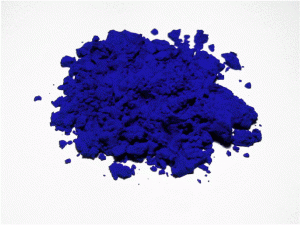“As I lay stretched upon the beach of Nice, I began to feel hatred for birds which flew back and forth across my blue sky, cloudless sky, because they tried to bore holes in my greatest and most beautiful work.”-Yves Klein, conceptual artist and inventor of International Klein Blue

Electric blue is roaring back into currency, and with it the man who stamped his imprimatur (and a registered patent) onto the shade, Yves Klein. This week the Walker Art Center in Minneapolis opens its doors on the first Yves Klein retrospective in nearly 30 years, a show that first opened last spring at the Hirshhorn Museum and Sculpture Garden in DC. Meanwhile, fall’s fashion runways were jam-packed with Klein’s patented shade, International Klein Blue, an almost palpably vibrant hue teetering between blue and purple. It’s thrilling, eye-wateringly strong, yet strangely calming. It exhausts, then renews the eye, just by looking at it. (You could even bookmark International-Klein-Blue.com for just this meditative purpose.)

Giorgio Armani

Jil Sander

Haider Ackermann

Artist and accessories designer Valeria McCulloch, who only wears International Klein Blue (IKB). As featured in a spread about IKB on Oprah.com
Who is Yves Klein, and what’s the story behind his unearthly color? Lolling on a beach in 1947, the wreckage of World War II still smoking up the historical (and perhaps literal) horizon, a teenage Klein carved up the universe of art between him and two friends. Painter Arman Fernandez chose earth, Claude Pascal words, while Klein claimed the sky. Here’s how one Klein biographer, Hannah Weitemeier, describes this apochryphal moment in postwar art: “With this famous symbolic gesture of signing the sky, Klein had foreseen, as in a reverie, the thrust of his art from that time onwards—a quest to reach the far side of the infinite.”
And seize the infinite blue he did. Klein’s first public exhibit in 1954 featured monochrome canvases in several shades—orange, pink, yellow as well as blue—but the audience’s placid reception enraged him, as if it were “a new kind of bright, abstract interior decoration,” as Weitermeier puts it. Klein’s response was to double down exclusively on what he considered the world’s most limitless, enveloping color: blue.

From Radicalart.info
With the help of Parisian paint dealer Edouard Adam, he suspended pure ultramarine pigment—the most-prized blue of the medieval period— in a synthetic resin called Rhodopas, which didn’t dull the pigment’s luminosity like traditional linseed oil suspensions. Their much-vaunted patent didn’t apply to the color proper, but rather protected Klein’s works made with the paint, which involved rolling naked ladies in the new hue and transferring their body-images to canvas.
Klein shows guaranteed two things: pots of daring, and pots (often literally) of blue. Invitees to two simultaneous 1957 exhibits received an blue-drenched postcard in the mail, complete with an IKB postage stamp actually canceled by the French postal service (an authentic touch Klein probably bribed his postman for). Handwritten by Pierre Restany, an art critic who helped translate Klein’s outre actions to a puzzled public, each invitation read: “The monochrome propositions of Yves KLEIN secure the sculptural destiny of pure pigment today. This grand history of the blue period will be retraced simultaneously on the walls of Colette Allendy and Iris Clert. RESTANY.” At a later exhibit, Klein served cocktails of gin, Cointreau and methylene blue, which – to his utter delight – stained everyone’s urine blue. Art penetrates indeed.

Hiroshima, 1961
International Klein Blue’s cultural moments act like the color: they burn intensely and flame out just as quickly, a cobalt phoenix of a color. The rising tide of IKB now flooding retailers’ shelves will surely recede in an electric-blue residue of sales racks, mounded with the color that so rapidly jades our collective eye.
It’s hard not to dismiss Yves Klein as a goldbricker—in a 1959-62 performance work Zones of Immaterial Pictorial Sensibility, buyers yearning to contemplate the void could buy empty lots (which Klein didn’t himself own) in exchange for bars of gold. At the same time, begrudgingly, you have to admit he’s onto something. More than half the world’s believers channel their God through blue: Jews contemplating the infinite, embodied in blue-fringed shawls; Muslims in Blue Mosques; Buddhists fingering turquoise beads as they pray, all thinking blue, blue, more blue. For all his brilliant chicanery, Klein’s aims as an artist, and his connection to his blue, were humbler than many realize: his goal was simply “to feel the soul without explaining it, without vocabulary, and to represent this sensation.”
Color is cagey, known and unknowable; you can approach but never quite tame it. In its funny, limited way, International Klein Blue reveals the pull of color in general, a wholly asymptotic charm.
